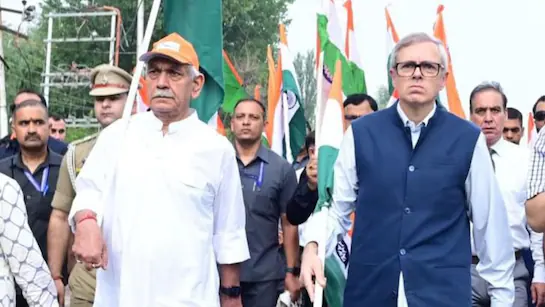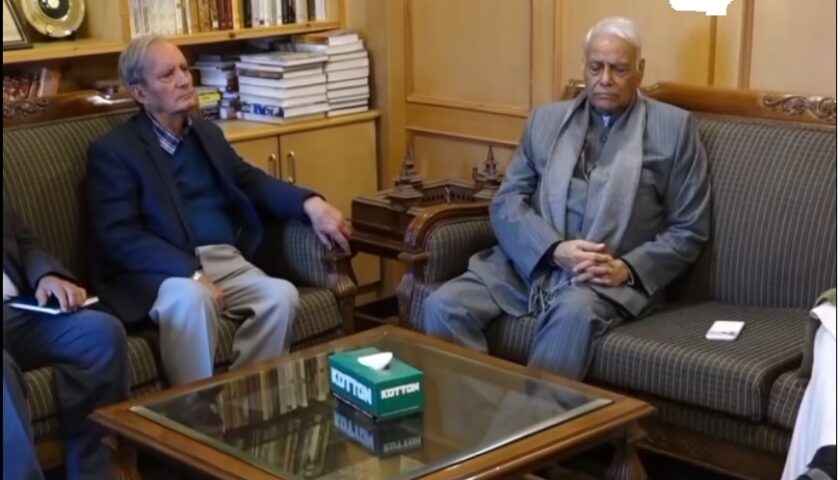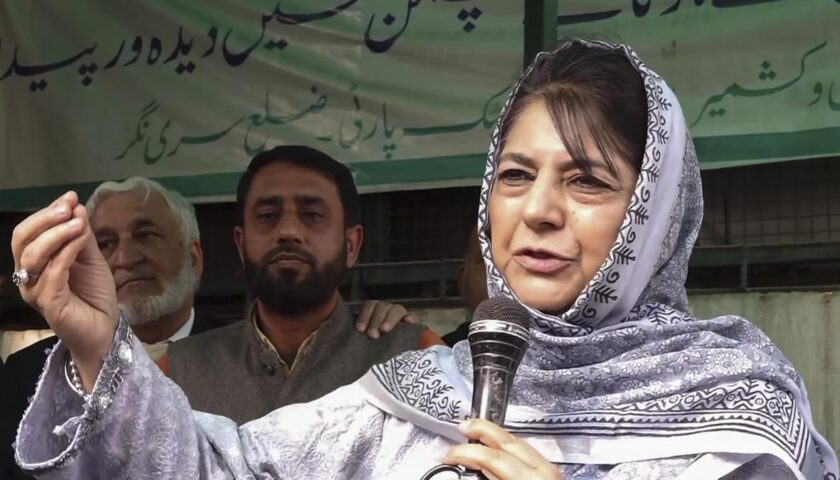J&K Statehood Clash | Omar Abdullah vs Manoj Sinha | Jammu & Kashmir Governance Rift
By: Javid Amin | 31 October 2025
In the political landscape of Jammu & Kashmir (J&K), a growing and increasingly public rift has emerged between two of the region’s most significant figures: Chief Minister Omar Abdullah and Lieutenant Governor Manoj Sinha. What might once have been a behind-the-scenes disagreement has now moved into full view, centred on one of the region’s most charged issues — the restoration of full statehood.
On the occasion of the UT Foundation Day (October 31 2025), the Lt Governor openly criticised the elected government for using the lack of statehood as an excuse for governance lapses. In heated response, Omar Abdullah fired back, pointing to recent security failures and calling upon the Centre to clarify the timeline for reinstating J&K’s status as a full-fledged state. This confrontation is more than a mere quarrel of personalities: it lays bare structural tensions in the governance model of J&K post-2019 and raises questions about accountability, autonomy and political legitimacy.
This article unpacks the origins, the latest flashpoint, the underlying issues at stake, and the possible fallout. We draw on ground reports, public statements and structural context to give a comprehensive, clear and human-centred analysis of this evolving crisis.
The Flashpoint: What Triggered the Dispute?
Lt Governor Sinha’s Public Rebuke
On the UT’s Foundation Day celebrations, at a gathering marking the fifth anniversary of J&K’s reconstitution as a Union Territory, Lt Governor Manoj Sinha criticised the elected government for allegedly misleading the people of J&K about the statehood question. He asserted that elected institutions already have full powers and that statehood could not be used as a ‘cover’ for under-performance.
He reiterated the Centre’s roadmap, emphasising that delimitation would precede assembly elections and then statehood would be restored “at an appropriate time”. He reinforced the message that the absence of statehood does not excuse governance gaps.
Omar Abdullah’s Retort
In response, Omar Abdullah called out the Lt Governor on issues of security and governance, pointing to the recent terror attack in Pahalgam in which 26 people were killed. He argued that if security responsibilities lay with the elected government, such an event would not have occurred.
He challenged the Centre (via the Lt Governor) to define clearly what “appropriate time” for statehood means — and asked: why should citizens wait when the promise had been part of electoral discussions?
The Broader Context
The clash isn’t just about two individuals having a verbal fight. It reflects deeper issues:
-
The dual-power structure in J&K, where an elected Chief Minister leads a government in a Union Territory overseen by a centrally-appointed Lt Governor.
-
The continuing demand for restoration of statehood after the revocation of special status in August 2019 and reorganisation into a UT, which remains unresolved.
-
The governance accountability: who is responsible for what, and how much real agency the elected leadership holds in the current framework.
Unpacking the Power Structure in J&K: Statehood, UT Status & Governance
From State to Union Territory
Until 2019, Jammu & Kashmir enjoyed statehood with special status under Article 370 of the Indian Constitution. In August 2019, the Government of India abrogated Article 370, reorganised the region and downgraded it into a Union Territory with a legislative assembly.
The 2024 Assembly elections brought the Jammu & Kashmir National Conference (JKNC) under Omar Abdullah back into power (with outside support from Congress) albeit in a model with constrained powers compared to a full state.
The Role of the Lt Governor
In the UT model, the Lt Governor holds stronger administrative and executive prerogatives compared to a state Governor. The elected government exists, but some key areas (e.g., security, land, police) remain under Union Government control or the Lt Governor’s purview — making the autonomous power of the elected leadership uncertain.
The Promise of Statehood
For many political actors in J&K, full restoration of statehood is a symbolic and functional demand — symbolically reinforcing self-governance, and functionally unlocking full constitutional powers of a state (such as full legislative competence, police powers, administrative autonomy). Omar Abdullah has insisted that the promise remains live.
However, the Centre (and the Lt Governor) assert there is a roadmap (delimitation → elections → statehood) and emphasise that the absence of statehood cannot excuse governance failures.
Governance Implications
The current tussle underlines several structural issues:
-
When an elected government blames the lack of statehood for under-performance, the Lt Governor counters that the available powers are sufficient.
-
The voter expectation of statehood must be balanced with the reality of administrative control and division of powers.
-
Political legitimacy: an elected government must deliver despite structural constraints; failure to do so may encourage public disillusionment.
The Political and Symbolic Stakes
For Omar Abdullah and the JKNC
Omar Abdullah is in a delicate position: having campaigned on a promise of statehood and greater autonomy, his government is now under pressure to show delivery. The public spat with the Lt Governor plays into this narrative — he needs to demonstrate not just rhetoric but results.
By publicly raising the issue of statehood and pointing to security failings, he positions himself not only as a regional leader but as a voice of democratic demand. This can boost base support but also raises the scrutiny of performance.
For Manoj Sinha and the Union Government
From the Centre’s perspective, the message from Sinha emphasises that J&K’s elected leadership should stop making “excuses” and fulfil governance responsibilities. The Centre wants to convey that UT status does not mean incapacity, and that they are advancing the structural roadmap for statehood.
At the same time, they maintain strategic control over key portfolios. The confrontation serves to reinforce the Centre’s role in J&K’s ongoing transition.
For the Electorate and Local Governance
For voters in J&K, this grievance-filled exchange brings into focus real questions:
-
Will statehood arrive? If so, when and under what conditions?
-
Regardless of statehood, how much difference does it make to their everyday lives (security, employment, infrastructure)?
-
Who is ultimately accountable — the elected government or the Lt Governor mandated by the Centre?
The outcome matters: public sentiment may shift if promises of statehood remain unfulfilled or if performance stagnates.
Key Flashpoints in the Exchange
“Appropriate Time” for Statehood
The Lt Governor cited the central government’s sequence: delimitation, then assembly polls, then statehood “at an appropriate time”. On this basis, he argued that lack of statehood is not an excuse for inaction.
Omar Abdullah pushed back hard: “What is the scale? What is the definition of appropriate time for statehood?” he asked. He also pointed out that parties (including his) had sought votes on the promise of statehood.
The Security Allegation: Pahalgam Attack
In his rebuttal, Omar pointed to the terror attack in Pahalgam (26 people killed) and argued that security is not his portfolio — so how can his government be asked to deliver if structural responsibilities lie elsewhere?
This argument is symbolic of the larger contest: who is answerable when things go wrong? The elected government is expected to deliver, but in many areas the Lt Governor or Centre retains control.
Governance and Performance Debate
The Lt Governor accused the government of using the absence of statehood as a pretext for inaction: “Other than statehood, all powers are with the (elected) government… they cannot use the excuse that work cannot be done until statehood is restored.”
Omar countered that this ignores the structural dependencies and that the promise of statehood is a genuine political expectation — and that he expects clarity on when and how it will be delivered.
What Does This Tell Us about J&K’s Political Future?
Scenario Analysis
-
Clarity and Delivery: If the Centre sets a clear timeline for statehood and the government simultaneously demonstrates improved performance, this confrontation may fade into the background as governance takes priority.
-
Stalemate and Stagnation: If statehood remains vague and public perception of governance decline grows, the elected leadership may lose credibility; internal friction may deepen and reform momentum stagnate.
-
Escalation and Opposition Victory: Should the dispute widen, opposition parties could capitalise on the leadership rift, prompting a reshuffle in local power balances ahead of future elections.
Implications for Governance
-
Power structures may need to be recalibrated: if statehood is restored, the division of portfolios must evolve; if not, the elected government must realistically deliver on available powers.
-
Accountability frameworks must be clear: voters should understand which authority is responsible for what.
-
Political legitimacy: the elected government must reconcile identity-based promises (statehood) with everyday governance delivery (jobs, infrastructure).
Social and Economic Dimensions
-
Youth expectations: With statehood unresolved, younger voters may focus more sharply on employment, education and connectivity rather than symbolism alone.
-
Investment and development: Investors and private sector stakeholders may hedge if governance and structural clarity remain uncertain.
-
Security and autonomy: The promise of statehood is seen as tied to local ownership of security, which remains politically salient in J&K.
Conclusion
The public clash between Omar Abdullah and Manoj Sinha over statehood in Jammu & Kashmir is more than a political spectacle — it is a warning sign of deeper institutional and legitimacy pressures in the Union Territory. The elected government is under pressure to deliver, the Lt Governor is asserting the primacy of governance irrespective of status, and the electorate is watching — with expectations of both symbolic justice (statehood) and tangible benefits (jobs, security, infrastructure).
How this dispute will resolve is far from certain. For now, the key questions remain: When will statehood be restored? What will it change? And who will be held accountable in the meantime? The answers will shape not only the political destiny of J&K but also the relationship between the region and the Centre — and between elected power and administrative control.




